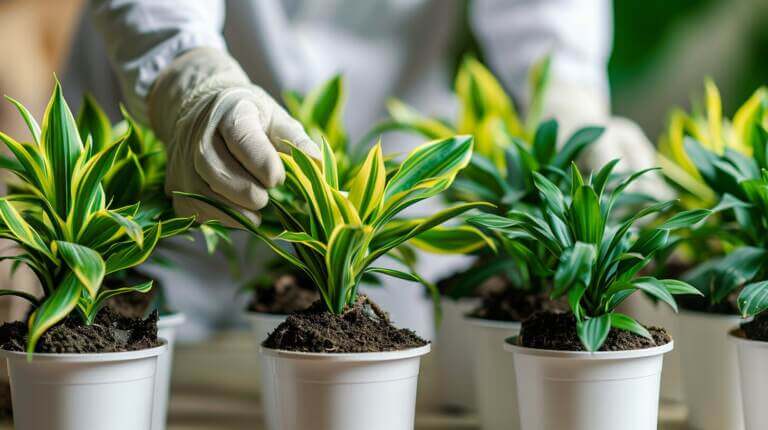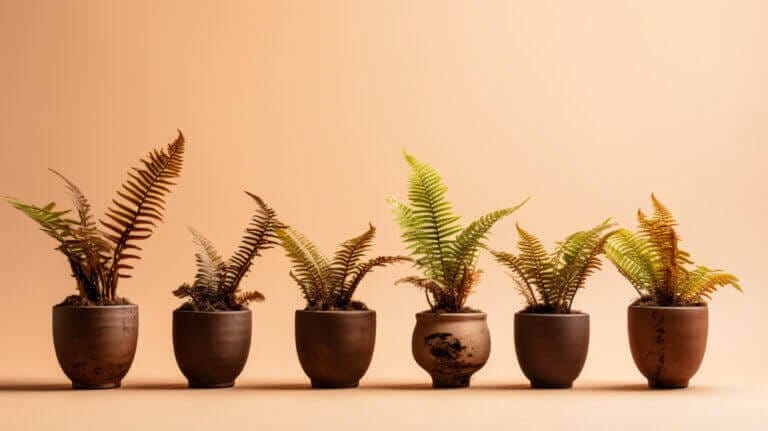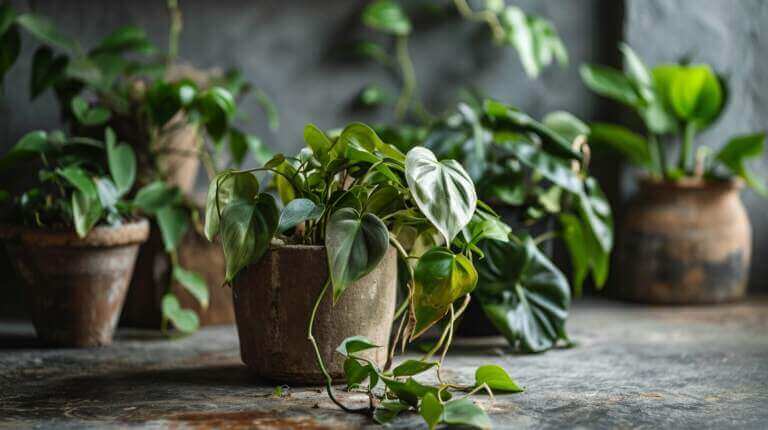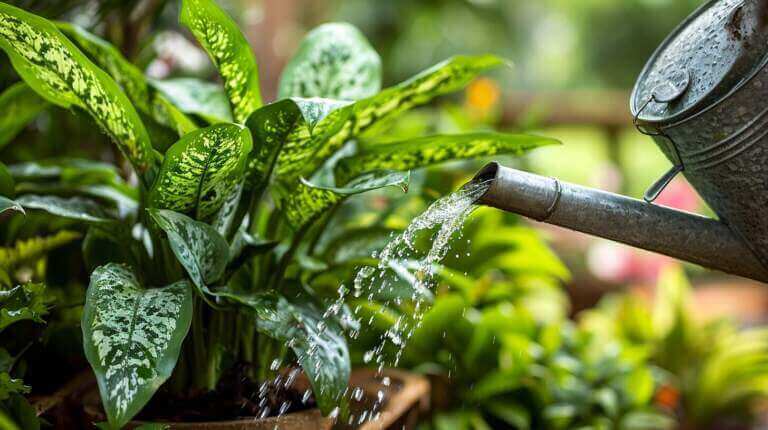Understanding How Much Light Does a Dracaena Need to Thrive?
Dracaena plants require specific light conditions to thrive and achieve their full potential as indoor houseplants. The amount of light they receive plays a crucial role in their growth, foliage development, and overall health. Understanding their light requirements is essential for providing the ideal environment for these beautiful plants to flourish.
Dracaena plants, including Dracaena marginata, thrive in bright, indirect light. They should be placed near a window with filtered sunlight or in an area with artificial light for optimal growth. It’s important to note that they do not tolerate direct sunlight well, as their leaves can burn and turn brown or yellow. While they can survive in low-light settings, they will not reach their full potential without some amount of sunlight.
Monitoring the light exposure and making appropriate adjustments is crucial to ensure the Dracaena plants’ well-being. Signs of too much light include brown, scorched patches on the leaves, indicating that the intensity of the light is too high. On the other hand, signs of too little light exposure are yellowing or dropping leaves and weak, leggy growth.
To keep your Dracaena thriving, it’s important to find the right balance of light. Placing them near a window with bright, indirect light or using artificial light sources in low-light areas can help create the ideal conditions for their growth. Regularly assessing the light exposure and making adjustments as needed will ensure that your Dracaena plants receive the optimal amount of light they need to thrive.
Key Takeaways:
- Dracaena plants require bright, indirect light to thrive.
- Direct sunlight can burn the leaves of Dracaena plants, causing them to turn brown or yellow.
- While they can survive in low-light conditions, Dracaena plants will not flourish without some amount of sunlight.
- Signs of too much light exposure include brown scorched patches on the leaves.
- Signs of too little light exposure include yellowing or dropping leaves and weak, leggy growth.
- Placing Dracaena plants near a window with filtered sunlight or using artificial light sources can help provide the optimal light conditions they need.
- Regularly monitoring the light exposure and making adjustments as needed will ensure optimal growth and thriving of Dracaena plants.
The Importance of Light for Dracaena’s Growth
Light plays a crucial role in the growth and development of dracaena plants, influencing their foliage and determining how well they can thrive indoors. Dracaena plants, including the popular Dracaena marginata variety, thrive in bright, indirect light. Placing them near a window with filtered sunlight or in an area with artificial light can provide the optimal conditions for their growth.
Direct sunlight can be detrimental to dracaena plants, as their leaves are sensitive and can easily burn, resulting in unsightly brown or yellow patches. While they can tolerate low-light settings, they will not reach their full potential without some amount of sunlight. It’s essential to strike a balance between providing enough light for healthy growth and ensuring the leaves are not exposed to excessive brightness.
Monitoring the light exposure of dracaena plants is crucial to their well-being. Signs of too much light include brown, scorched patches on the leaves, indicating that the plants are receiving more light than they can handle. On the other hand, signs of insufficient light exposure include yellowing or dropping leaves and weak, leggy growth. Regularly assessing the plant’s foliage and adjusting the amount of light they receive can help maintain their vitality and lush appearance.
To ensure optimal growth, it is recommended to place dracaena plants in a spot that provides bright indirect light or filtered sunlight. If natural light is limited, supplementing with artificial light sources, such as grow lights, can be beneficial. By providing the right balance of light and making necessary adjustments, you can help your dracaena plants thrive and enjoy their lush foliage for years to come.
Light Requirements for Different Dracaena Varieties
While all dracaena plants have similar light requirements, it’s important to note that different varieties may have specific preferences. For example, Dracaena marginata, with its distinctive red-edged foliage, thrives in bright indirect light. Placing it near a north-facing window or in an area with bright indirect light can promote its optimal growth and enhance its striking appearance. Avoid exposing Dracaena marginata to direct sunlight, as this can cause leaf burning and compromise its overall health.
Finding the Right Amount of Light for Dracaena
To ensure your dracaena thrives, it’s crucial to find the right balance of light exposure, avoiding both excessive direct sunlight and insufficient low light conditions. Dracaena plants, including the popular Dracaena marginata variety, thrive in bright, indirect light. Placing your dracaena near a window with filtered sunlight or providing artificial light in the right intensity can help promote optimal growth and lush foliage.
Direct sunlight is not suitable for dracaena plants, as it can lead to leaf burning and discoloration. If your dracaena leaves develop brown or yellow patches, it may be a sign that they are receiving too much light. On the other hand, if your dracaena is not getting enough light, you may notice yellowing or dropping leaves, as well as weak and leggy growth.
To determine the right amount of light for your dracaena, consider the natural light conditions in your home. If you have a north-facing window, it typically provides indirect sunlight, which is ideal for dracaena plants. However, if your home doesn’t have sufficient natural light, you can supplement it with artificial light sources. There are various types of grow lights available that mimic natural sunlight and can be adjusted to provide the right amount of light for your dracaena plants.
| Signs of Too Much Light | Signs of Too Little Light |
|---|---|
| • Brown or scorched patches on leaves | • Yellowing or dropping leaves |
| • Discoloration and browning | • Weak, leggy growth |
Monitoring the light exposure of your dracaena plants is essential for their well-being. Adjust the positioning of your plants and the amount of light they receive as needed to ensure they thrive. By finding the right balance of light for your dracaena, you can enjoy their vibrant foliage and healthy growth.
Best Light Conditions for Dracaena Marginata
Dracaena marginata plants thrive when placed in areas with bright indirect light or north-facing windows that provide abundant filtered sunlight. These light conditions mimic their natural habitat and promote optimal growth and vibrant foliage. It is important to avoid placing them in direct sunlight, as excessive exposure can lead to scorched leaves and browning.
When positioning your Dracaena marginata, consider the intensity and duration of the light it will receive. Bright indirect light refers to light that is diffused or filtered through curtains, blinds, or sheer materials, ensuring the leaves are not directly exposed to the sun’s rays. This soft, indirect light is the perfect balance for these plants.
For north-facing windows, the natural light that enters is generally indirect and provides a lower intensity compared to windows facing other directions. This makes them ideal for Dracaena marginata plants, as they will receive ample light without the risk of sunburn.
Creating the Optimal Lighting Environment
To ensure your Dracaena marginata thrives, you can enhance the lighting conditions by placing it near a north-facing window or utilizing artificial light sources. When using artificial lighting, choose a source that closely mimics natural light, such as full-spectrum grow lights. These lights provide a balanced spectrum of wavelengths that promote photosynthesis and healthy plant growth.
Remember to monitor your plant for signs of inadequate or excessive light exposure. Brown, scorched patches on the leaves indicate too much light, while yellowing or dropping leaves suggest not enough light. Adjust the positioning of your plant or the intensity of artificial light to maintain a healthy balance and ensure your Dracaena marginata continues to flourish.
| Lighting Conditions | Effect on Dracaena Marginata |
|---|---|
| Bright indirect light or north-facing window | Promotes optimal growth and vibrant foliage |
| Direct sunlight | Leads to scorched leaves and browning |
| Low light or insufficient sunlight | Results in yellowing or dropping leaves and weak growth |
By providing the best light conditions and monitoring your Dracaena marginata’s response, you can ensure the continued health and beauty of this popular plant variety.
Supplementing Light with Artificial Sources
In low light conditions or when natural light is limited, dracaena plants can benefit from the use of artificial light sources like grow lights to ensure they receive the necessary light for growth. While dracaena plants can survive in low-light settings, they will not thrive without some amount of sunlight. Artificial lights provide an effective solution to supplement natural light and create optimal conditions for the plants to flourish.
Grow lights are specifically designed to emit the appropriate spectrum of light that plants need for photosynthesis. They provide a convenient and efficient way to ensure dracaenas receive sufficient light, especially in spaces where sunlight is limited. When choosing artificial light sources, it is important to consider the light intensity and duration. Most dracaena varieties require around 12-14 hours of light per day, so it is crucial to set up a lighting schedule that mimics natural day and night cycles.
There are various types of grow lights available, including fluorescent, LED, and high-intensity discharge (HID) lights. LED lights are particularly popular among plant enthusiasts due to their energy efficiency, long lifespan, and adjustable light spectrums. They can be easily adjusted to emit the optimal wavelengths of light for dracaena growth, promoting healthy foliage and strong, vibrant plants.
Choosing the Right Grow Light for Dracaena
When selecting a grow light for your dracaena plants, it is essential to consider their specific light requirements. Dracaena marginata, for example, thrives in bright indirect light. To meet their needs, opt for a grow light that emits light in the red and blue spectrums, as these wavelengths are crucial for photosynthesis and plant growth. Aim for a light intensity of around 2,000 to 3,000 lumens per square foot.
It is also important to position the grow light at the right distance from the plants. Typically, the light should be placed about 12 inches above the dracaena foliage. However, it is recommended to monitor the plants closely and adjust the height accordingly to ensure they are receiving the optimal amount of light without causing any light burn or stress.
| Types of Grow Lights | Light Spectrum | Recommended Distance |
|---|---|---|
| Fluorescent | Blue and red spectrum | 12-18 inches |
| LED | Customizable spectrum | 12 inches |
| HID | Blue and red spectrum | 24-36 inches |
Remember that while artificial lights can supplement natural light, they should never replace it entirely. Where possible, dracaena plants should still be placed near a window with filtered sunlight to ensure they receive a sufficient amount of natural light. By carefully balancing natural and artificial light sources, you can create the ideal lighting conditions to help your dracaena plants thrive.
Signs of Inadequate or Excessive Light Exposure
Monitoring the light levels your dracaena plant receives is crucial to avoid detrimental effects such as leaf scorch, brown tips, yellowing leaves, or weak growth. These signs indicate that your dracaena is not receiving the right amount of light and adjustments need to be made to ensure its optimal health and development.
If your dracaena is exposed to too much direct sunlight, the leaves may develop brown, scorched patches. This occurs because the intense sunlight can burn the delicate foliage, leading to unsightly discoloration. On the other hand, if your dracaena is not receiving enough light, the leaves may start to turn yellow or drop off altogether. Weak, leggy growth is also a common indication of insufficient light.
It is important to find the right balance for your dracaena’s light exposure. Bright, indirect light is generally best for these plants, such as placing them near a window with filtered sunlight. If natural light is limited in your space, you can also supplement with artificial light sources to provide the necessary brightness. By ensuring your dracaena receives the right amount of light, you can prevent these issues and promote its thriving growth.
| Signs of Inadequate Light Exposure: | Signs of Excessive Light Exposure: |
|---|---|
| – Yellowing leaves | – Brown, scorched patches on leaves |
| – Dropping leaves | – Weak, leggy growth |
| – Weak growth |
Keep a close eye on your dracaena and observe any changes in its foliage or growth. Regularly adjusting the light exposure can help prevent these issues and ensure that your dracaena thrives. Remember, finding the right balance of light is essential for the optimal health and well-being of your dracaena plants.
Tips for Providing Optimal Light Conditions
By strategically placing your dracaena plant near a window with bright indirect light or filtered sunlight, you can ensure it receives the right amount of natural light for thriving growth. Dracaena plants, including the popular Dracaena marginata variety, thrive in bright, indirect light. Placing them near a window allows them to benefit from the filtered sunlight, which provides the ideal light conditions.
It is important to avoid exposing your dracaena plant to direct sunlight, as this can cause the leaves to burn and turn brown or yellow. Instead, opt for bright indirect light, which is gentle yet sufficient for its growth. If your available windows do not provide the desired light conditions, you can also consider supplementing with artificial light sources.
When using artificial light, make sure to place the dracaena plant within a suitable distance to receive the necessary amount of light. Consider using grow lights specifically designed for indoor plants to provide the light needed for their optimal growth. Keep in mind that even with artificial light, it is important to maintain a balance and not expose the plants to excessive light.
Key tips for providing optimal light conditions:
- Place your dracaena plant near a window with bright indirect light or filtered sunlight.
- Avoid direct sunlight, as it can cause leaves to burn and turn brown or yellow.
- Consider supplementing with artificial light if natural light is insufficient.
- Use grow lights designed for indoor plants at an appropriate distance from the plant.
- Monitor light exposure and adjust as necessary to ensure the dracaena plant thrives.
Remember, maintaining the right amount of light exposure is crucial for the optimal growth and health of your dracaena plant. By following these tips, you can create the perfect light conditions for your dracaena to flourish.
| Dracaena Light Requirements | Ideal Light Conditions | Signs of Inadequate Light | Signs of Excessive Light |
|---|---|---|---|
| All Dracaena Varieties | Bright indirect light or filtered sunlight near a window | Yellowing or dropping leaves, weak growth | Brown or scorched patches on leaves |
| Dracaena Marginata | Bright indirect light or filtered sunlight near a north-facing window | Yellowing or dropping leaves, weak growth | Brown or scorched patches on leaves |
Summary and Key Takeaways
Understanding the light requirements of dracaena plants is essential for their optimal growth and overall well-being, allowing you to adjust the light exposure accordingly to ensure they thrive in your indoor space. Dracaena plants, including the popular Dracaena marginata variety, thrive in bright, indirect light. It is important to place them near a window with filtered sunlight or provide them with artificial light to promote their growth.
Direct sunlight is not suitable for dracaena plants, as it can cause their leaves to burn and turn brown or yellow. While they can tolerate low-light conditions, they will not flourish without some amount of sunlight. It is crucial to monitor the light exposure and make adjustments as needed to keep your dracaena thriving.
Signs of too much light include brown, scorched patches on the leaves. If you notice these signs, it’s important to move the plant to a spot with less direct light. On the other hand, signs of too little light include yellowing or dropping leaves and weak, leggy growth. In such cases, you should consider providing additional light sources, such as artificial lights, to supplement the natural light they receive.
Remember, dracaena plants rely on light for photosynthesis, which is crucial for their growth. By finding the right balance of light exposure through bright indirect light or artificial light sources, you can ensure that your dracaena plants thrive and add a touch of natural beauty to your indoor space.
FAQ
What kind of light does a Dracaena plant need to thrive?
Dracaena plants thrive in bright, indirect light. They should be placed near a window with filtered sunlight or in an area with artificial light for optimal growth. They do not tolerate direct sunlight well, as their leaves can burn and turn brown or yellow.
Can Dracaena plants survive in low-light settings?
While Dracaena plants can survive in low-light settings, they will not flourish without some amount of sunlight. Signs of too little light include yellowing or dropping leaves and weak, leggy growth.
What are the signs of too much light exposure for a Dracaena plant?
Signs of too much light exposure for a Dracaena plant include brown, scorched patches on the leaves.
How can I adjust the light exposure for my Dracaena plant?
It is important to monitor the light exposure and make adjustments as needed to keep the Dracaena thriving. This can be done by moving the plant to a location with less or more light, or by using curtains, blinds, or other methods to filter the amount of light it receives.
Can I use artificial light for my Dracaena plant?
Yes, artificial light can be used to supplement natural light for Dracaena plants. Grow lights or other similar artificial light sources can provide the necessary light needed for the plant’s growth in low-light conditions.
How do I know if my Dracaena plant is not getting enough light?
If your Dracaena plant is not getting enough light, you may notice yellowing leaves, dropping leaves, and weak, leggy growth.
How do I know if my Dracaena plant is getting too much light?
If your Dracaena plant is getting too much light, you may notice brown, scorched patches on the leaves.
What are some tips for providing optimal light conditions for my Dracaena plant?
Some tips for providing optimal light conditions for your Dracaena plant include placing it near a window with filtered sunlight, ensuring it receives a few hours of indirect light each day, and controlling the amount of light exposure by using curtains or blinds.







